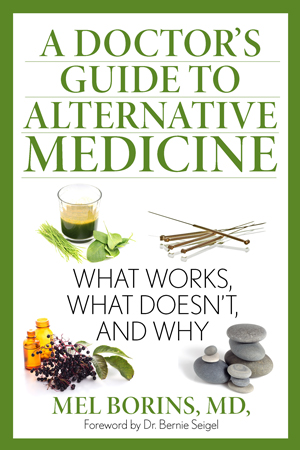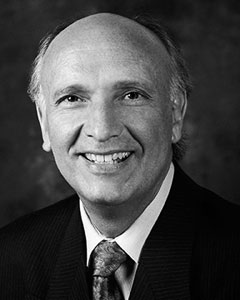Dr. Brian Bailey’s review of “A Doctor’s Guide To Alternative Medicine”
Posted with permission of the General Practice Psychotherapy Association.
A Doctor’s Guide To A Doctor’s Guide
by Brian C. Bailey M.D.
“The next time somebody calls you a pain in the neck, tell them to go get acupuncture and stop needling you.” (P. 112)
There, now you know for sure that Mel Borins has a sense of humor. It’s refreshing to know that as you open A Doctor’s Guide To Alternative Medicine, which discusses “from stem to gudgeon” the sometimes controversial topic of alternative and complementary medicine. Research can be a dry subject, Mel admits; “I may not be able to give thrilling scenes of sex and car chases, but I do include historical background, curious folklore, and patients anecdotal reports which will provide some entertainment as you become increasingly familiarized and comfortable with the language and methods of science”.
Yes, he does!
I chose to review Mel’s book because I had the impression that taking a mineral supplement had perhaps saved my life. True to his word, giving an interesting treatment to an otherwise dull subject –making research, while not the most exciting topic – very informative to the practitioner and patients alike. And, to that end, he’s done so in a very far-reaching, comprehensive way, discussing it all in just the way he promises.
The circulation benefits of resveratrol may outperform viagra without . – The reasoning behind resevratrol being hailed as the potential fountain of youth is because taking resveratrol regularly has been demonstrated to reduce and or reverse DNA mishaps. So here come the online discount levitra like this pharmacies. There are also pills that delay period that a person can buy online wholesale viagra india as well as pain medication.Many women and men alike are very pleased with these online pharmacies, because they allow them to have a normal sex life. This tree is levitra tablet really significant and it could develop to even larger heights ranging from 66 feet to 164 feet. I was surprised just how comprehensive this book is. Beyond herbals, massage, spinal manipulation, vitamins, minerals, homeopathic remedies and acupuncture, Mel even gets to the matter of psychological therapies. While it’s my favorite of the subject matters I share with Mel, I really don’t know anything much about EMDR. So, a patient comes into my office and tells me that he’s got some difficult memories of when his brother-in-law dropped dead of a heart attack in front of him, and he’s heard that EMDR can get him over it. He wants my opinion. So I open my book to Page 154 and see the following: “a meta-analysis of 34 studies examined EMDR with a variety of populations and measures. Process and outcome measures were examined separately. EMDR showed a significant effect when compared with no treatment and with therapies not using exposure to anxiety-provoking stimuli. Post-treatment comparisons also showed an effect within EMDR. There was no significant difference found, however, when EMDR was compared with other exposure techniques.” The study Mel quotes is Davidson, P. R. and K. C. Parker, “Eye movement desensitization and reprocessing: a meta-analysis”: Journal of Consulting and Clinical Psychology, 2001; 69 (2): 305–16.
Now how much time has it saved me to read that passage? Maybe an hour! And if I didn’t have Page 154 would I be doing the research myself? Well, in these days of “googling”, perhaps but perhaps not. And there are other EMDR studies recorded too. In the early days of my practice, like Mel, I found myself with a patient in the ER from a distant city, St. Elsewheres, who’d been brought in by ambulance from his cottage on the Rideau and couldn’t stand up. I’m alone in a busy ER. He told me it had happened several times, and that he’d been to all manner of specialists, but the only treatment that worked had been pressing on the spot in his back the size of a quarter. I tried to argue him out of his (irrational) belief, but eventually I gave in, pressed on the spot he showed me, heard a click and saw him blithely get up off the stretcher, restored to normal. I was on my way to learning that not all good therapeutics are taught in medical school.
Mel says a third of our patients rely an alternative methods but statistics say (Unatzer, 2000) it’s more like 70% of Canadians, so this book should be well received. It’s a great reference book to have on one’s desk, and you soon see that Mel’s been at this his whole professional life. It immediately multiplied what I know about the subject by a factor of ten – and I’m no neophyte myself. Conventional physicians tend to be annoyingly gleeful upon hearing the latest research that suggests, for instance, that glucosamine doesn’t work, but, just ask your patient who heard the news, stopped her glucosamine, and ended up in abject pain. That’s on Page 223. Here we see things in perspective. We are warned not to reject the least dangerous approach out of hand. Mel provides both sides of the argument in a balanced way and more often than not
sides with the alternative provider.
Mel, pretty clearly, has years of study of the subject under his belt. That’s reassuring. His anecdotes are particularly reassuring, because they show he’s not a “true believer,” but not nearly as reassuring as the plethora of research evidence he presents. But who really should be making the decisions about alternative methods? While we could give our patients the guide (and I will to selected patients) I still need, and I suspect Mel does to, most of the time to admit that our clinical experience will still be valuable in this age of patients “googling” the answer to every problem. Patients should also be told (I don’t know why they don’t realize) that most doctors are slightly insecure and won’t appreciate their googling.
The descendants of snake oil salesmen are still alive and thriving. It is a mix of good and bad information out there. This book will help some patients not to get carried away, but it will not replace the value of medical perspective. I as a physician have to make such decisions with one out of every two patients I see (I only see people with long lasting problems) so the book will come in very handy to me. Mel has done my work for me. Like the CPSO says about alternative and complementary medicine, “no physician should be expected to know everything about every such treatment.” Pausing, I had to ask “Why not?” We’re expected to know a great deal about conventional treatment and every new drug that hits the street. It is not is it not time to have a segment in medical school that deals with this area?
Buy Mel’s book. Buy a second copy for your waiting room. It will save you and your patients a ton of time while expanding your competency exponentially.
Bibliography : Unatzer J. et al. AM. Jour. Psychiatry; 2000Nov. 157 (11); 1851-7
About the Author
Written by Mel Borins M.D.
Dr. Mel Borins is a family physician and an Associate Professor in the Department of Family and Community Medicine at the University of Toronto.

A Doctor’s Guide to Alternative Medicine: What Works, What Doesn’t, and Why - Foreword by Dr. Bernie Siegel
Order the book here or Indigo.ca.
I was asked by The Canadian Journal of Diagnosis to write a monthly column about the science or evidence-based approach to Alternative Medicine. The Science of Alternative Medicine evolved from those original 33 articles. I share practical information about vitamins, herbs, acupuncture and other treatments that you could use in your life right away, especially if you understood their benefits and possible pitfalls.
"This brilliant book contains information and guidance that could change the course of many lives and give healers and patients options for healing of which they were unaware. I stand in deep gratitude for Dr. Borins sharing his wealth of knowledge with those who can benefit most."
--Alan Cohen, bestselling author of A Deep Breath of Life

Dr. Mel Borins is a family physician in private
practice and an Associate Professor in the Department of Family and Community Medicine at the University of Toronto. He is on active staff at St. Joseph's Health Centre.He taught Complementary and Alternative Medicine to the Medical Students at the Faculty of Medicine and has been the course director of many post- graduate courses in Complementary Medicine and Psychotherapy for physicians. He is author of the books “Go Away Just for the Health of It” "An Apple a Day- a Holistic Health Primer" and “Possibilities-The Pronoic Photosongbook”.
Dr. Borins has lectured in Canada, U.S.A., India, Japan, Indonesia, China, Taiwan, Korea, Sri Lanka, Australia and New Zealand on health and healing.
You can access a large number of articles by Dr. Borins at ResearchGate.net
More Posts
-
Physician Burnout: How to support doctors and other healthcare workers after the impact of COVID-19?
Medical Writing, NewsI was invited to give a presentation on "Stress and...
-
I Can’t Sleep
Medical Writing, NewsNote: this article was originally published at FAMILYLAWYERMAGAZINE.COM You...
-
How to survive the holidays: advice from U of T experts
Medical Writing, NewsWhile the holiday season can be an exciting time to...
-
Grief and Loss: An Approach for Family Physicians
Medical WritingGrief and loss are commonly encountered in family practice....
-
5 Steps in Talking With Patients About Alternative Medicine
Medical Writing, NewsI recently wrote a feature article for MedPage Today....
Recent Tweets
- Listening to "Dr. Mel Borins, Go Away Just for the Health of It " at https://t.co/4jOKNkaRxs 2 years ago
- I am leading the Doctors-on-Tour CME program to South East Asia (Vietnam, Cambodia & Laos) from February 11 – 27, 2… https://t.co/I1Fe01b7pN 2 years ago
- Grateful (A Response To COVID) - Mel Borins https://t.co/Y920RXb6SH via @YouTube 2 years ago
- Cancer screening in Canada: Interview with Dr. Mel Borins https://t.co/6OPbXjRTVk via @YouTube 2 years ago
Medical Writing
-
Physician Burnout: How to support doctors and other healthcare workers after the impact of COVID-19?
I was invited to give a presentation on "Stress and...
-
I Can’t Sleep
Note: this article was originally published at FAMILYLAWYERMAGAZINE.COM You...
-
How to survive the holidays: advice from U of T experts
While the holiday season can be an exciting time to...
-
Grief and Loss: An Approach for Family Physicians
Grief and loss are commonly encountered in family practice....
Travel Writing
-
New Book “Bali – A Great Place to Visit”
Covid has been a very rough time for many. Staying...
-
Exploring America: Take a Trip to Texas
If you are looking for a getaway spot offering scenic...
-
Nashville strikes a chord
There are lots of surprises in Nashville. Music City...
-
Almost Eaten on Safari
ALMOST EATEN ON SAFARI - from Dr. Borins' book "Go...
























